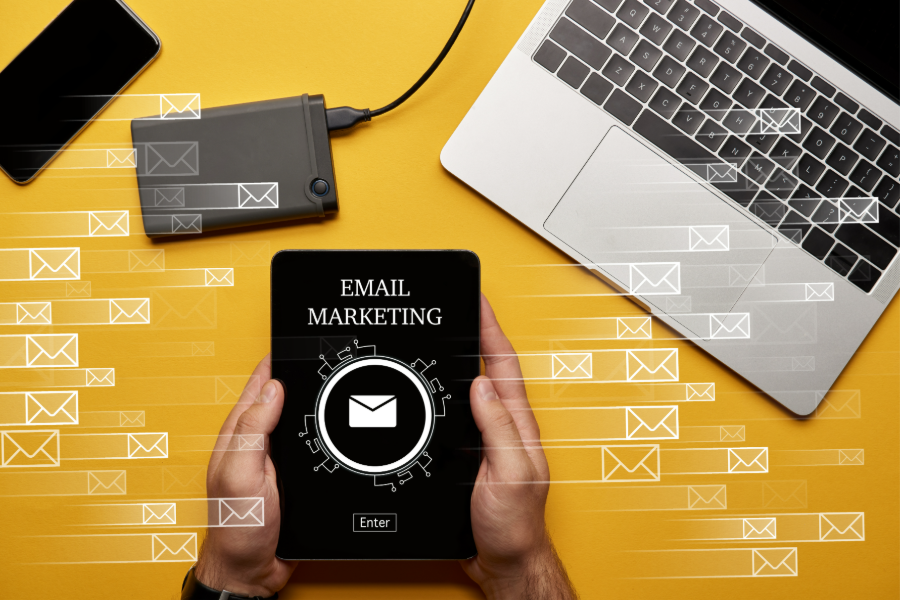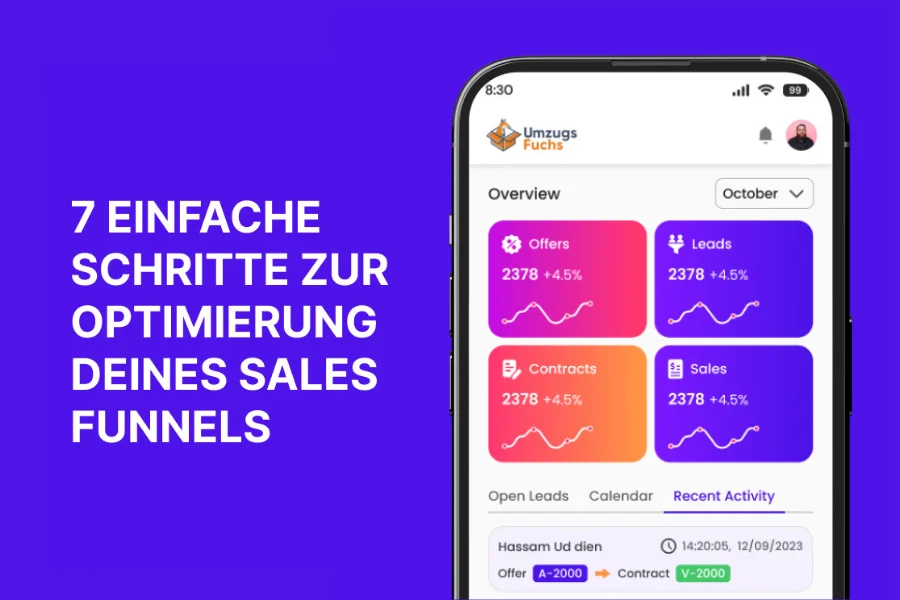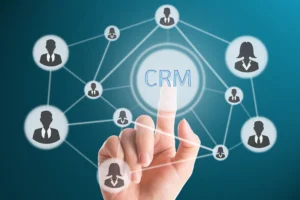A well-optimized sales funnel is the backbone of any successful sales strategy. It guides potential customers from the first contact to the final conversion – efficiently, clearly structured, and goal-oriented. Büro 365 offers a comprehensive business management solution that simplifies this process – but the fundamentals of funnel optimization apply equally to all platforms. In this article, we will show you seven simple but crucial steps to optimize your sales funnel and achieve sustainable success.
What does Sales Funnel Optimization mean?
Sales funnel optimization refers to the process of strategically improving each stage of your sales funnel – with the goal of qualifying more leads, increasing conversions, and making the entire sales process more efficient. The "funnel" symbolizes the journey potential customers take from their first encounter with your offer to the desired action (e.g., purchase, newsletter signup, appointment booking). The goal is to minimize friction points, eliminate obstacles, and create as simple and convincing a customer journey as possible.
The AIDA Model – The Stages in the Sales Funnel

The proven AIDA model helps to understand the individual stages in the funnel:
- Attention: Capture attention – through ads, social media, content marketing, etc.
- Interest: Deepen curiosity – with relevant information, problem-solving, and suitable offers.
- Desire: Create desire – through customer testimonials, case studies, or clear benefits.
- Action: Trigger the final step – e.g., purchase, booking, or inquiry.
7 Steps to Optimize Your Funnel
1. Define Your Sales Funnel
Before optimizing, you need a clear structure. Only when you know and can name the individual funnel stages can you identify weaknesses and improve them effectively.
Here's how to do it:
- Visualize the funnel: Sketch all the steps a customer goes through – e.g., attention, interest, decision, action.
- Adapt it to your industry: A SaaS company, for example, has different funnel stages (like a "Free Trial") compared to an online shop.
- Set criteria: What counts as "interest," what as "decision"? For example: A contact inquiry = interest, a received price inquiry = decision phase.
2. Clearly Define Your Target Audience
A sales funnel only works when you're addressing the right people. The better you understand your audience, the more targeted and convincing you can communicate.
Here's how to do it:
- Conduct market research: Analyze demographic and psychographic data of your target audience. Use surveys, interviews, or CRM analysis.
- Create customer personas: Define ideal customer types – with information about roles, goals, challenges, decision-making behavior, etc.
- Use segmentation: Divide your audience into meaningful segments and tailor content, offers, and messaging accordingly.
3. Optimize Landing Pages and Website Experience
Your landing page is often the first direct touchpoint with your offer. It's here that a prospect decides whether to become a lead – or not.
Here's how to do it:
- Clear messaging: It must be immediately apparent what you're offering and the value you deliver.
- Mobile-friendly design: Ensure that all pages function perfectly on smartphones and tablets.
- Call-to-action (CTA): A clear button, such as "Get Started Now" or "Book a Demo," must be visible and convincing.
- Visual support: Videos or infographics help explain your offer and build trust.
4. Create Relevant and Engaging Content
Good content is one of the most important drivers in the sales process. Content helps build trust and guide potential customers through the funnel.
Here's how to do it: Strategically plan your content
- Content strategy by funnel stage:
For the awareness phase, blog articles or explainer videos that answer common questions are ideal.
In the desire phase, focus on case studies, product demos, or customer testimonials. - Content suitable for each funnel stage:
- Awareness: Blog articles, infographics, guides
- Interest: Webinars, eBooks, how-to guides
- Desire: Testimonials, use cases, product demonstrations
- Action: Special offers, discounts, free trials
- Keep it concise and valuable:
Avoid information overload. Focus on content that is truly helpful to your audience at each stage of the funnel.
5. Utilize Email Marketing & Automation
Email marketing remains one of the most effective tools for funnel optimization. Automated email sequences ensure consistent interaction and increase conversion rates.

Here's how to do it: Use emails strategically
- Segment email lists:
Divide your contacts by interests, behavior, or funnel stage for greater relevance. - Use drip campaigns:
Send automated emails in a logical sequence – for example, Welcome > Information > Case Study > CTA. - Personalization:
Address recipients by name, refer to their interests, and tailor content to their funnel position. - Measure success:
Monitor open rates, clicks, and conversions to improve your campaigns effectively.
6. Build Trust Through Social Proof & Certifications
Trust is a fundamental prerequisite for any conversion. Testimonials, reviews, or awards can be crucial.
Here's how to do it: Make trust visible
- Incorporate customer quotes and case studies:
Show how other customers have successfully used your product. - Display certifications and awards:
Show security, industry, or quality seals as proof of trust. - Use user-generated content:
Let satisfied customers speak for you on social media – and feature their content on your website.
7. Funnel Optimization Using Data
Without analysis, there is no optimization. Understanding where leads drop off or get lost allows you to make targeted improvements and increase conversions.

Here's how to do it: Improve based on data
- Measure conversion rates:
Track how many leads move from one funnel stage to the next – for example, with Google Analytics or your CRM. - Conduct A/B tests:
Test different versions of landing pages, CTAs, or email subject lines – and use the better-performing version. - Observe user behavior:
With heatmaps or session recordings, you can see where users drop off or get lost – and make targeted optimizations.
Why a Smooth Funnel is So Important
A well-optimized sales funnel…
- Increases your conversion rate
- Improves the user experience
- Helps retain existing customers
- Makes your marketing more efficient
- Increases your revenue in the long term
Conclusion
Optimizing your sales funnel is a key lever for sustainable growth. With the right steps – from defining your target audience to content strategy, automation, and data-based analysis – you can turn prospects into loyal customers. Tools like Büro 365 help you efficiently manage the entire funnel process – from lead generation to closing the deal. Stay focused, continuously optimize, and rely on proven best practices – so your business stays competitive and grows healthily.
FAQs
1. What is a sales funnel?
A sales funnel describes the steps a potential customer goes through – from the first contact to interest and desire, all the way to the final action (e.g., purchase, demo, sign-up).
2. How can I improve my funnel conversions?
Optimizing each stage is key: clear landing pages, relevant content, targeted email campaigns, and A/B tests help move more leads to the closing stage.
3. What role does content play in the funnel?
Content guides prospects through the stages – from informative blog posts to convincing case studies, all the way to final offers.
4. Why is email marketing so important in the funnel?
Because it continuously nurtures leads. Automated, personalized emails deliver relevant content at the right time – and lead step-by-step to conversion.
5. What analytics metrics should I keep an eye on?
Conversion rates per funnel stage, bounce rates, click behavior, and time spent on pages are essential. Tools like Google Analytics or CRM systems provide meaningful data for this.



